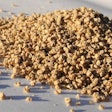
Many reports now emphasise the contribution of farm animal-related activities to environmental problems such as eutrophication, ammonia (NH3) emission and odour nuisance. Nitrogen (N) excretion is an important factor in poultry growing.
Nitrogen utilisation
Vegetable and/or animal protein sources provide most of the crude protein (CP) to chickens. Supplementation of synthetic amino acids lysine, methionine, and threonine is done to manage the essential amino acid content. However, the amount of amino acids available to birds is often much greater than the quantity contained in feedstuffs, leading to excretion of the excess. Excreted N from chickens is in the form of uric acid (88%), ammonia (NH3; 10%), and urea (5%). Microbial breakdown of uric acid leads to generation of NH3.
Consequences of excretion
Impact on environment - Direct application of animal waste to the land can lead to surface run-off and loss of N and phosphorus. Leaching of nitrates (NO3) and especially phosphorus pentoxide (P2O5) results in eutrophication of ground-water and then, surface water. NH3 contributes to acidification and eutrophication of ecosystems.
Impact on health - Reports show that chickens and turkeys continuously exposed to 20 parts/million (ppm) NH3 exhibit significant respiratory tract damage after six weeks. Chicks exposed to 20ppm NH3 for 72 hours were much more susceptible to Newcastle disease than those reared in NH3 -free environments. NH3 levels in excess of 100ppm in a layer house may reduce egg production.
Reducing excretion
It is possible to reduce N excretion economically.
Application of ideal amino acids in diet formulation - Using digestible amino acid values rather than apparent digestibility values is a first step in formulating feeds to the birds' dietary requirements. Requirements for amino acids depend on other dietary components, sex, age and body composition. Expressing amino acid requirements as a ratio to lysine are followed to express ideal amino acid ratios. Several ideal amino acid ratios have been published for broilers. Similar data in layers and breeders would help efforts to develop precision based feed formulations.
Evaluation of feed ingredients - Various factors affect amino acid composition and proximate analysis can be used to manage the variations in feedstuffs. Near-infra red spectroscopy is now an established technique for assessing nutrients and can substantially reduce the standard deviation values.
Maize as an example of energy source - Due to higher inclusion rate in the diet of birds, maize contributes more than 50% of dietary fibre in a typical maize-soybean meal diet. Variation in fibre leads to differences in nutrient concentration and digestibility. For example, a co-efficient of variation (CV) of 16% has been found for starch digestibility in maize. Similarly, the CP content of maize varies from 8-11%, while lysine content is in the range 1.8-2.0%.
Soybean meal as an example of vegetable protein source - Variations in concentration as well as quality of amino acids in soybeans and soybean meals have been found. Although some of these differences are explained by processing conditions, genetic make-up and growing conditions of the soybeans also determine the composition of soybean meal. Inadequate heat processing reduces the digestibility of amino acids in soybean meals. The metabolisable energy value of soybean meal was improved 12% by removing raffinose and stachyose.
Experimental background for protein reduction
Reducing CP - Our knowledge of requirements suggests that it is theoretically possible to reduce CP content of poultry diets. However success has been limited for two reasons:
For example, if CP content is reduced from 19.0% to 14.2% in a maize-soybean meal diet, methionine content is reduced from 0.28% to 0.24%, while lysine content is reduced from 0.92% to 0.69%. The lysine content in the final diet is reduced more than methionine.
It may be possible to reduce CP content of the diets by two percentage points if essential amino acids are supplemented although some researchers have found that supplementing a diet with amino acids other than methionine, lysine, tryptophan and threonine may prove uneconomical.
It has been shown that there is greater scope for diets with reduced CP for layers, although others have achieved limited success with this practice. Lysine supplementation of diets with low CP (13.6%) increased egg production, egg mass and egg weight in one experiment while in another, supplementing diets with other limiting amino acids (threonine, arginine and tryptophan) helped maintain performance by laying hens fed low-CP diets.
Feeding programmes - Phase feeding is one technique used to manage N excretion. Commercial phase feeding programmes may include as many as six phases to step down dietary CP (22% to 16%), amino acids and other nutrients for broilers. Similar reports on nutrient refinement can be applied to broiler breeders and commercial laying hens. Economics and convenience will most likely drive the implementation of additional phases of dietary protein.
Conclusions
Controlling nitrogen dynamics offers an economical method to control environmental pollution: reducing dietary crude protein reduces nitrogen excretion and ammonia emissions. Better knowledge of requirements will improve diet formulations.
Table 1: Partitioning of feed nitrogen in poultry
Table 2: Ideal amino acid profiles for broilers similar in different publications
Table 3: Practical matrix value for diet formulation depends on the mean CP value and standard deviation of ingredients

